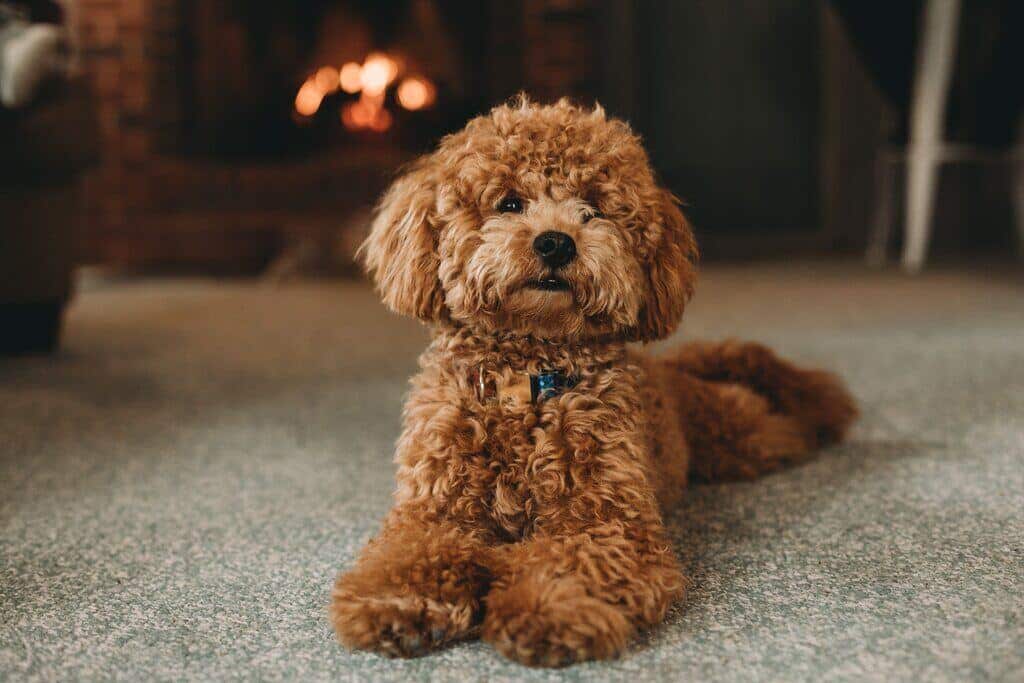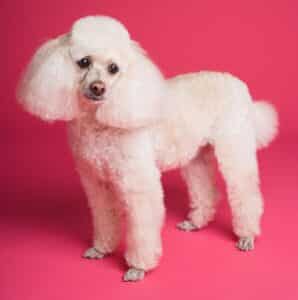What is a Standard Poodle?
A Standard Poodle is a moderate-to-large-sized dog. A well-groomed dog gives off the impression of having a square shape. Its tail measures roughly half its body length from tip to base. The skull has moderate rounding at its base with a distinct stop. It has a long, straight muzzle. Dark, oval-shaped eyes are set slightly farther back than normal and are either black or brown. The ears hang close to the head and are long and flat. Both the front and rear legs are in proportion with each other. The headline is level. The tail is held up straight. Sometimes, dogs’ tails are shortened so they appear more balanced. Dewclaws may be removed. Oval-shaped feet are quite small and the toes are slightly curved. It’s either curly or cordoned. You’ll find it in all solid colors like black, blue, silver, gray, cream, apricots, red, white, brown, or café au lait. Some breeders may be breeding for parti-colors but they don’t necessarily write them down.
Canis lupus familiaris
Male: 55-60 lbs.
Female: 45-50 lbs.
15 yrs.
Black Black & White
Brown
White
Sable
Silver
Apricot
Blue
Red
Cream
Grey
15 inches and taller (usually 22 inches)
Intelligent
Active
Faithful
Alert
Instinctual
Trainable

Temperament
Poodles are known for their intelligence, energy, and social skills. Both mental and physical activity is required for them to be effective. A typical Poodle usually behaves like an independent individual when meeting people for the first time. However, he may become friendly if he gets used to his owner’s presence. The aggressive, mean behavior is considered a major fault in the breed. A Poodle is usually quiet and calm, but when they’re really certain there’s trouble nearby, they become extremely protective of their owner, his/her family members, and even strangers.
A poodle is a highly trainable dog that usually excels at obedience training. A Poodle will be able to excel at most dog sports, but especially dog agility flyball dock dive, dog surfing, tracking disc, and Schutzhund. For the larger-sized Poodles, they may also excel at dog sports such as dog agility flyball dock jumping, dog agility flyball dock swimming, and dog Hiking and camping trips are great for dogs because they get exercise, socialize, and play together. Their background as duck dogs means centuries of instinctive attraction to water and thus they can go on any trip involving swimming, whether in the sea, at the lake, or even in whitewater up to class III for the Standard, though a lifejacket is paramount for all of the above. Even though most individual dogs, including some breeds who are known for their talent at swimming such as the Chesapeake Bay Retrievers, need a gentle introduction to water when they’re young, all of them eventually learn to swim well enough to be able to enjoy themselves in the water without any training. Poodles need to be taught that water is not just for drinking but also for playing.
Amongst the sizes available, Standard Poodles tend to be the best choice for families with young kids. For centuries, poodles were bred primarily by aristocratic families who wanted large, elegant dogs. As such, they’ve often been associated with wealth and high society. Assuming that stereotype is true for children and teens is a big mistake because the truth is they’ll be delighted by an opportunity to play outside, no matter whether it involves jumping into mud puddles or playing catch in the backyard. Their cheerful disposition makes them fun to be around; they enjoy playing games that stimulate their curiosity and creativity. As an example, young kids would probably enjoy hiding from their parents and then finding them again. The Standard Poodle would enjoy playing sports like baseball or tennis with children and teens because that means catching waywards balls in his mouth. They’d be delighted to play with a child on a skateboard in spring, ride a toboggan with toddlers in winter, or swim together at the beach in summer if they’ve learned how to safely use the steps to leave and basic dog safety rules first.
All puppies need time to get used to new people before they become comfortable enough for them to play well together. Most standard poodles will accept a baby and learn to behave gently towards children once introduced. If there’s no need for an obedience class, then a Standard Poodle would probably be okay in a home with lots of kids provided they get regular exercise and plenty of time off from play when their owners aren’t looking.
Because young children are usually bigger than Miniature Poodle and Toy Poodles, these breeds might be frightened by some of their actions. They may be aggressive because they’re afraid; therefore, they’re best for households where there are young kids or teens. Some poodles may be prone to anxiety when they’re left alone for long periods of time, but their behavior isn’t typical of a dog who suffers from nervous disorders. If you treat miniature and toy poodles like children, they’ll act like them too! They won’t listen to their owners when they’re told “no” or “wait.” Instead, they’ll think they own the world and that everyone owes them something. And if you don’t give them attention, they may even get aggressive.

Adaptability
Poodles are usually good for families because they’re easygoing and tolerant of children and pets. Because of their sensitive natures, dogs may become overly stressed when exposed to too much noise or activity. Puppies are best suited for families with younger kids.
If your dog has become anxious because he lives in an environment where there’s too much noise, chaos, or conflict, then you need to change his surroundings so they don’t cause him stress. A Poodle prefers and appreciates a calm, quiet environment.
Health
We know that because you care so much about your dog, you want to take good care of her. That is why we have summarized the health concerns we will be discussing with you over the life of your Poodle. By knowing about health concerns specific to Standard Poodles, we can tailor a preventive health plan to watch for and hopefully prevent some predictable risks.
Many diseases and health conditions are genetic, meaning they are related to your pet’s breed. There is a general consensus among canine genetic researchers and veterinary practitioners that the conditions we’ve described herein have a significant rate of incidence and/or impact in this breed. That does not mean your dog will have these problems; it just means that she is more at risk than other dogs. We will describe the most common issues seen in Standard Poodles to give you an idea of what may come up in her future. Of course, we can’t cover every possibility here, so always check with us if you notice any unusual signs or symptoms.
Standard Poodle Training
Since the late 1980s, some breeders in the United States and Canada have been selecting dogs with a drive for birds in order to revive the breed for hunting, with some success.
Poodles have been used as working dogs in the military since at least the 17th century, most likely because of their highly intelligent, trainable nature and background as a gundog making them suitable to battlefields, as evidenced by their ability to be trained to ignore gunfire. During the English Civil War, Prince Rupert of the Rhine hunting Poodle he brought over with him from what is today Germany with a white coat who liked to ride into battle with his master on horseback.
Napoleon wrote in his memoirs that he had been told by one of his grenadiers’ Poodle dogs that its owner was dead after the battle of Marengo. He then went back into the battlefield where he found the dog sitting next to the corpse of its master. When asked why the dog did not leave when he saw the death of its master, the dog replied “I am faithful.”
Grooming
A Standard Poodle’s body structure includes a roundish, moderately sized head; a long face and muzzle; black, oval eyes; and wide, close-fitting ears. Their short bodies allow them to move quickly through tall grasses. Docking their tails gives them balance when they jump up onto high perches. And having small feet helps them get into tight spaces. Sometimes the coat is curly and wiry, but not always; sometimes it’s soft and wavy, but not always; and it can be any solid color (not just black).
There are several grooming styles including the pet clip (shorter than the English saddle style), the Continental clip (with the hindquarters shaved but no part of the tail), and the English saddle style (where the hindquarter is shaved and the tail is left long). Show dogs usually come with the Continental clip.
Physical Needs
Because poodles require lots of physical activity and opportunities for movement, having an expansive outdoor space where they can run free is essential. Make sure you take lots of time out of each day to walk and visit your puppy at an outdoor location where they’ll be safe from traffic and people. A poodle is an excellent choice for someone who loves nature. They’re naturally adventurous and enjoy swimming, so they make great companion pets for people who live near bodies of water.
You shouldn’t leave them home alone if they’re not housebroken because they’ll definitely miss you when you come back. Don’t let him go for long periods without human contact. He needs plenty of affection from humans and dogs alike!
Life Span
They are a relatively healthy breed and can live up to 15 years, learn more.
Photo by Steven Van Elk on Unsplash
